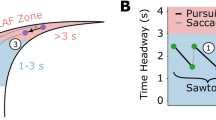Abstract
Previous work has demonstrated that distinct gaze patterns precede certain driving manoeuvres [1,2] and that they can be used to build an artificial neural network model which predicts a driver’s intended manoeuvres [3,4]. This study seeks to move closer towards the goal of using gaze data in Advanced Driver Assistance Systems (ADAS) so that they can correctly infer the intentions of the driver from what is implied by the available incoming data. Drivers’ gaze behaviour was measured in a dynamic driving simulator. The amount of gaze data required to make predictions that manoeuvres will occur and the reliablity of these predictions at increasing pre-manoeuvre times were investigated by using various sized windows of gaze data. The relative difficulty of predicting different manoeuvres and the accuracy of the models at different pre-manoeuvre times are discussed.
Access this chapter
Tax calculation will be finalised at checkout
Purchases are for personal use only
Preview
Unable to display preview. Download preview PDF.
Similar content being viewed by others
References
Lethaus, F., Rataj, J.: Do eye movements reflect driving manoeuvres? IET Intelligent Transport Systems 1(3), 199–204 (2007)
Lethaus, F., Rataj, J.: Using eye movements as a reference to identify driving manoeuvres. In: Proceedings of the FISITA World Automotive Congress 2008, vol. 1, Springer Automotive Media, Wiesbaden (2008)
Lethaus, F.: Using eye movements to predict driving manoeuvres. In: Europe Chapter of the Human Factors and Ergonomics Society Annual Conference, Linköping, Sweden (2009)
Lethaus, F., Baumann, M.R.K., Köster, F., Lemmer, K.: Using Pattern Recognition to Predict Driver Intent. In: Dobnikar, A., Lotrič, U., Šter, B. (eds.) ICANNGA 2011, Part I. LNCS, vol. 6593, pp. 140–149. Springer, Heidelberg (2011)
Henderson, J.M., Ferreira, F.: Scene perception for psycholinguists. In: Henderson, J.M., Ferreira, F. (eds.) The Interface of Language, Vision, and Action: Eye Movements and the Visual World, pp. 1–58. Psychology Press, New York (2004)
McCall, J.C., Wipf, D.P., Trivedi, M.M., Rao, B.D.: Lane change intent analysis using robust operators and sparse Bayesian learning. IEEE Tranactions on Intelligent Transportation Systems 8(3), 431–440 (2007)
Oliver, N., Pentland, A.P.: Graphical models for driver behavior recognition in a SmartCar. In: Proceedings of IEEE Conference on Intelligent Vehicles, Detroit, MI, USA (2000)
Rumelhart, D.E., Hinton, G.E., Williams, R.J.: Learning internal representations by error propagation. In: Rumelhart, D.E., McClelland, J.L. (eds.) Parallel Distributed Processing, vol. 1, pp. 318–362. MIT Press, Cambridge (1986)
Author information
Authors and Affiliations
Editor information
Editors and Affiliations
Rights and permissions
Copyright information
© 2013 Springer-Verlag Berlin Heidelberg
About this paper
Cite this paper
Lethaus, F., Harris, R.M., Baumann, M.R.K., Köster, F., Lemmer, K. (2013). Windows of Driver Gaze Data: How Early and How Much for Robust Predictions of Driver Intent?. In: Tomassini, M., Antonioni, A., Daolio, F., Buesser, P. (eds) Adaptive and Natural Computing Algorithms. ICANNGA 2013. Lecture Notes in Computer Science, vol 7824. Springer, Berlin, Heidelberg. https://doi.org/10.1007/978-3-642-37213-1_46
Download citation
DOI: https://doi.org/10.1007/978-3-642-37213-1_46
Publisher Name: Springer, Berlin, Heidelberg
Print ISBN: 978-3-642-37212-4
Online ISBN: 978-3-642-37213-1
eBook Packages: Computer ScienceComputer Science (R0)




